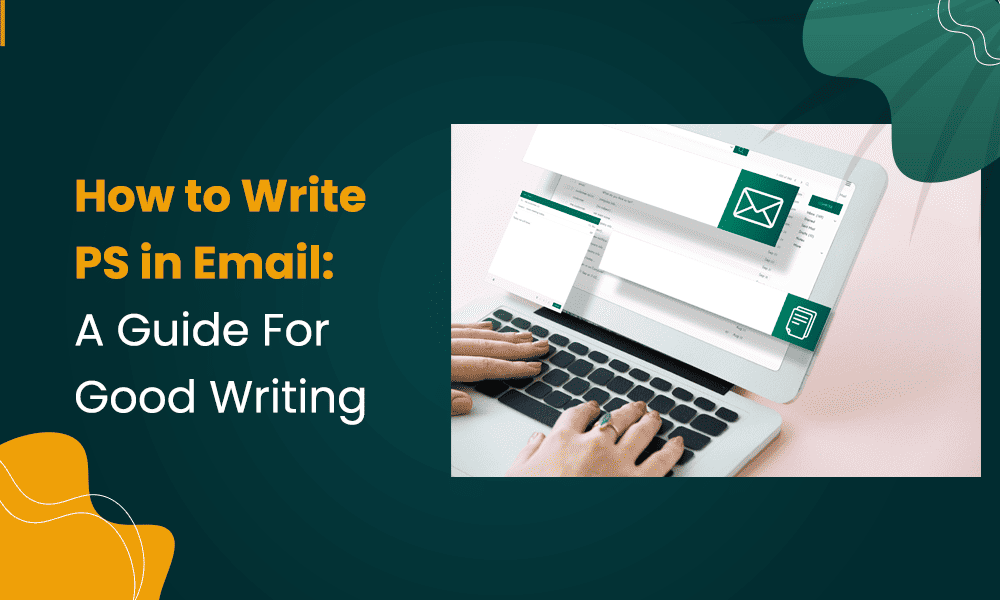We’ve all seen it used in emails before, and perhaps you’ve even sent it to others when issuing an email. We’re talking about a little acronym that makes a big difference – PS.
Do you know what PS stands for and how to incorporate it into social media or email marketing properly?
If not, this guide will tell you everything you need to know. We’ll explain what PS means, how to format it, and how professional the usage of PS is.
We’ll also include some great examples of how to write PS in emails, so make sure you read till the end.
Table of Contents
PS in Emails – What Does It Mean, Anyway?

So, how do you know you’re using PS right? Let’s dive right in and see what PS means.
PS is short for postscript, which comes from the Latin term post scriptum. That translates to “written after.”
That’s quite apt, considering the usage of PS. You’ll add this section to an email or correspondence when you have an afterthought to share.
While the person writing the email or correspondence could always go in and edit their thought into the body of the email, leaving out the PS, there’s something charming about writing PS in messages.
So, how do you know if you’re writing PS in your emails correctly? That’s simple. If you include it at the end of your message, you’re doing it right.
You should add your postscript after you’re done with whatever you had to say in the email.
Read also: How To Say ‘Please Find Attached’ In 20 Different, Smarter Ways
Formatting and Punctuating PS – Everything You Need to Know
Next, let’s talk further about how to make the inclusion of PS in your emails look nice.
Formatting PS isn’t difficult. There’s no need to indent the PS paragraph outside of how you’ve indented the other paragraphs in your email.
You also don’t have to bold or italicize the PS paragraph. The presence of the postscript initials–PS–brings enough attention to the content at the end of your email.
Now, you’ve probably seen PS punctuated two different ways: PS, as we’ve referred to it this entire time, or P.S.
So which is correct? Both are!
Truly, it comes down to personal preference whether you’ll use P.S. or PS.
Your location also plays a role, as using periods in the postscript is more common in the United States, while omitting them is standard in the United Kingdom.
It’s up to you which you’ll choose, but consistency is essential. If you write PS, then add PPS, you should stylize it as so, not as P.P.S.
Also, whether you use punctuation marks or not, you should always capitalize both letters of the PS acronym.
Read also: The Right Way Of Saying ‘Sorry for the Inconvenience’
Enhance Your Email Marketing
Want to make your emails more impactful? Check out our beautiful, easy-to-customize HTML email templates. Designed to boost engagement, these templates from EngageBay will help your emails stand out. Just customize the images, headings, and CTAs for your brand, and hit send in a few minutes!
How to write PS in a professional email
Whether it’s an internal email to fellow staff or a message to a customer or lead, feel free to use PS when appropriate in your correspondence. Even if you’re a paper writer drafting formal communication, here are some instances in which postscript comes in handy.
Here are some instances in which postscript comes in handy.
Make a point
If you want to reiterate a point to your reader, especially when sending an otherwise long email, use PS.
Don’t simply copy and paste the reiterated text from the body of the email and insert it into the postscript section. Instead, rewrite the point, this time for even more clarity.
Using PS in this way ensures your primary goal doesn’t get lost in the body of the email, especially if you go over a lot of other pertinent information in your content.
To incentivize a lead or customer on a deal
Once you’ve gotten your audience to a certain point in the sales funnel, you want them to act. Use a postscript in your email if you have a deal or bonus to incentivize your leads or customers to take that next step.
You can mention more about the deal in the postscript, such as how it’s a limited-time offer or that you’ll also throw in free shipping.
If a lead or customer was on the fence before, they should feel motivated to make a purchasing decision.
Read also: Gmail Cleanup: Unleash the Power of an Organized Inbox Today!
To provide more information about a new product or service
Unveiling a new product or service is an exciting but stressful time. You can use a postscript in your email with a hyperlink to the new product/service to provide more information should the lead or customer be interested.
Is it professional to write PS in business correspondence?
Then again, how professional is it to include PS as an email ender when sending business emails?
It’s not something you’ll see in every business email or even most. However, it does have its purpose and thus shouldn’t be omitted from emails altogether.
Ultimately, whether you use PS in a business email depends on what kind of tone you’re aiming for.
Postscript gives off a more casual tone, so if that’s not the attitude you wish to convey in your correspondence–such as when sending a formal message–it’s best to forego the use of PS.
How to write PS in a personal email
When sending personal correspondence, you’re a lot likelier to use a postscript. In a personal email, there’s far less pressure, and you can’t really get it “wrong” like you can in a professional email.
That said, following the postscript best practices we’ve laid out to this point will help you write personal emails using PS properly.
Read also: How And When To Say ‘My Sincerest Apologies’
PPS – What Does It Mean and How Is It Different from PS?

We have to talk about another abbreviation you’ll sometimes see in emails that’s awfully similar to PS. It’s PPS.
What is PPS, and how is it used? And how does it differ from PS?
PPS is a secondary postscript added after the initial PS in your email or correspondence. It’s yet another opportunity to add your afterthoughts.
This collection of afterthoughts should differ from the ones included in your original postscript.
You can write PPS as-is or add periods between each letter, such as P.P.S. Whatever formatting you used for your first postscript should follow for the second.
PS vs PPS – How they’re different
Ultimately, both PS and PPS postscripts give you the opportunity to include additional thoughts that you omitted from the original body of your email or letter.
The main difference between them comes down to perception.
While a well-timed postscript slots into emails nicely–especially personal emails but some professional emails too–there’s less love for the secondary postscript PPS.
Unless you keep both postscripts very short, they can quickly become cluttered, taking over your email and distracting from your main point.
Including both superscripts could come across as unprofessional.
That’s not to say you can never use PPS, but before you do, consider whether you can include all the information in a single postscript.
The Best Examples of Using PS in Email
To show you how PS can conclude professional and personal emails alike, we’ve compiled this section full of handy examples!
1. Promotionally

Although this promotional PS doesn’t tie into the rest of the email content, it’s still a great way to get eyes on the paper the writer recently published!
2. To help readers catch up

Try as they may, your audience might not read your every email. To get them caught up about once a month, you can send a message with a postscript as seen above. It’s sure to come in handy!
Read also: Mastering Email Format: Essential Guide for Small Business Owners
3. To throw in a tip
Do you want to ensure your audience will read your postscript? Post a valuable nugget of information in there not found elsewhere in your message, as seen here.

This is also a great example of an email that uses both PS and PPS postscripts exceptionally well!
Read also: How To Insert a GIF Into an Email Like a Pro
4. As a built-in CTA

A postscript is a valuable opportunity to insert a CTA. More novel than an email signature, the key is to keep your CTA quick and to the point. Try bolding it to draw more eyes to the postscript!
👉 Create and launch successful email campaigns with EngageBay’s all-in-one solution and stunning, free email templates. Don’t miss out — get started today!
Postscript Best Practices
Before we wrap up, we want to share some best practices to keep in mind when utilizing postscripts in your correspondence.
Use it sparingly
Like many email accouterments such as emojis, the inclusion of postscript can turn from novel to stale very quickly.
You shouldn’t use PS in every single letter or email you send; not even close. Postscripts come in handy for adding an important point after the fact.
If you have nothing additional to include when wrapping up your email, it’s fine to skip the postscript.
Add it to the correct part of your email
The postscript must go in the correct location in an email or letter. You should always sign off and then add the PS.
Keep your postscript punctuation consistent
This goes back to our point from before. Whether you prefer the periods in PS and PPS, or you’d rather omit them, use them consistently in your correspondence. Otherwise, it will come across as confusing to your reader!
Read also: Kind Regards: How to Nail your Email Signature
Don’t write paragraph upon paragraph
If you have a point that you can make in a couple of sentences, add a PS. However, if your point requires several paragraphs, it’s better off added to the body of your letter or email.
No one wants to plod through an overly lengthy postscript!
Read also: How to Write the Best Meeting Reminder Email
Conclusion
Adding a postscript to your emails–aka using PS or PPS–is intended to express an afterthought not originally included in your letter or email.
The concept of postscript came about centuries ago before it was so easy to go back and edit your correspondence like computers and smartphones today have made it.
Postscripts continue to survive in the digital age, where you can insert them into personal and professional correspondence alike. Although they’re best used sparingly, postscripts add a certain charm to your message and make it a more informal read.
Now that you better understand how postscripts work and how you format them, you’re ready to insert them into your emails and letters when needed. Check out our stunning email templates to step up your email campaigns! Good luck!

